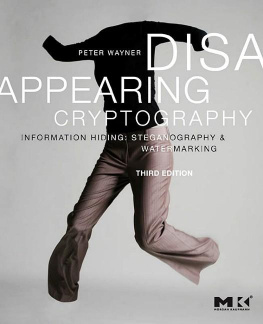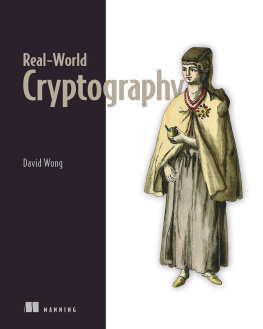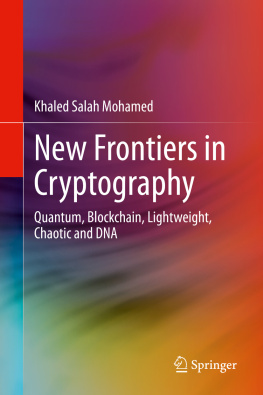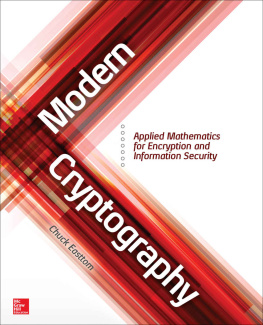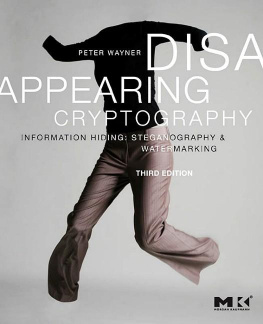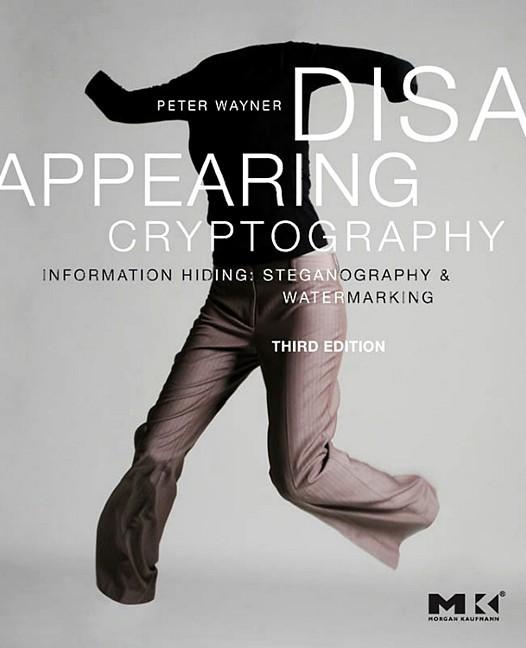Wayner - Disappearing cryptography: information hiding: steganography & watermarking
Here you can read online Wayner - Disappearing cryptography: information hiding: steganography & watermarking full text of the book (entire story) in english for free. Download pdf and epub, get meaning, cover and reviews about this ebook. City: Boston, Amsterdam, year: 2009, publisher: Morgan Kaufmann Publishers;Elsevier, genre: Computer. Description of the work, (preface) as well as reviews are available. Best literature library LitArk.com created for fans of good reading and offers a wide selection of genres:
Romance novel
Science fiction
Adventure
Detective
Science
History
Home and family
Prose
Art
Politics
Computer
Non-fiction
Religion
Business
Children
Humor
Choose a favorite category and find really read worthwhile books. Enjoy immersion in the world of imagination, feel the emotions of the characters or learn something new for yourself, make an fascinating discovery.
Disappearing cryptography: information hiding: steganography & watermarking: summary, description and annotation
We offer to read an annotation, description, summary or preface (depends on what the author of the book "Disappearing cryptography: information hiding: steganography & watermarking" wrote himself). If you haven't found the necessary information about the book — write in the comments, we will try to find it.
These methods include encryption, compression, data embedding and watermarking, data mimicry, and scrambling. During the last 5 years, the continued advancement and exponential increase of computer processing power have enhanced the efficacy and scope of electronic espionage and content appropriation. Therefore, this edition has amended and expanded outdated sections in accordance with new dangers, and includes 5 completely new chapters that introduce newer more sophisticated and refined cryptographic algorithms and techniques (such as fingerprinting, synchronization, and quantization) capable of withstanding the evolved forms of attack. Each chapter is divided into sections, first providing an introduction and high-level summary for those who wish to understand the concepts without wading through technical explanations, and then presenting concrete examples and greater detail for those who want to write their own programs.-
This combination of practicality and theory allows programmers and system designers to not only implement tried and true encryption procedures, but also consider probable future developments in their designs, thus fulfilling the need for preemptive caution that is becoming ever more explicit as the transference of digital media escalates. Read more...
Abstract: Cryptology is the practice of hiding digital information by means of various obfuscatory and steganographic techniques. The application of said techniques facilitates message confidentiality and sender/receiver identity authentication, and helps to ensure the integrity and security of computer passwords, ATM card information, digital signatures, DVD and HDDVD content, and electronic commerce. Cryptography is also central to digital rights management (DRM), a group of techniques for technologically controlling the use of copyrighted material that is being widely implemented and deployed at the behest of corporations that own and create revenue from the hundreds of thousands of mini-transactions that take place daily on programs like iTunes. This new edition of our best-selling book on cryptography and information hiding delineates a number of different methods to hide information in all types of digital media files.-
These methods include encryption, compression, data embedding and watermarking, data mimicry, and scrambling. During the last 5 years, the continued advancement and exponential increase of computer processing power have enhanced the efficacy and scope of electronic espionage and content appropriation. Therefore, this edition has amended and expanded outdated sections in accordance with new dangers, and includes 5 completely new chapters that introduce newer more sophisticated and refined cryptographic algorithms and techniques (such as fingerprinting, synchronization, and quantization) capable of withstanding the evolved forms of attack. Each chapter is divided into sections, first providing an introduction and high-level summary for those who wish to understand the concepts without wading through technical explanations, and then presenting concrete examples and greater detail for those who want to write their own programs.-
This combination of practicality and theory allows programmers and system designers to not only implement tried and true encryption procedures, but also consider probable future developments in their designs, thus fulfilling the need for preemptive caution that is becoming ever more explicit as the transference of digital media escalates
Wayner: author's other books
Who wrote Disappearing cryptography: information hiding: steganography & watermarking? Find out the surname, the name of the author of the book and a list of all author's works by series.

